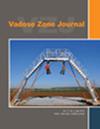A model for saturated–unsaturated flow with fractures acting as capillary barriers
IF 2.8
3区 地球科学
Q3 ENVIRONMENTAL SCIENCES
引用次数: 0
Abstract
High‐resolution modeling of the flow dynamics in fractured soils is highly complex and computationally demanding as it requires precise geometrical description of the fractures in addition to resolving a multiphase free‐flow problem inside the fractures. In this paper, we present an idealized model for saturated–unsaturated flow in fractured soils that preserves the core aspects of fractured flow dynamics using an explicit representation of the fractures. The model is based on Richards’ equation in the matrix and hydrostatic equilibrium in the fractures. While the first modeling choice is standard, the latter is motivated by the difference in flow regimes between matrix and fractures, that is, the water velocity inside the fractures is considerably larger than in the soil even under saturated conditions. On matrix/fracture interfaces, the model permits water exchange between matrix and fractures only when the capillary barrier offered by the presence of air inside the fractures is overcome. Thus, depending on the wetting conditions, fractures can either act as impervious barriers or as paths for rapid water flow. Since in numerical simulations each fracture face in the computational grid is a potential seepage face, solving the resulting system of nonlinear equations is a nontrivial task. Here, we propose a general framework based on a discrete‐fracture matrix approach, a finite volume discretization of the equations, and a practical iterative technique to solve the conditional flow at the interfaces. Numerical examples support the mathematical validity and the physical applicability of the model.以裂缝为毛细管屏障的饱和-非饱和流动模型
断裂土壤中流动动力学的高分辨率建模非常复杂,对计算要求很高,因为除了要解决断裂内部的多相自由流动问题外,还需要对断裂进行精确的几何描述。在本文中,我们提出了一种理想化的断裂土壤中饱和-非饱和流动模型,该模型通过明确表示裂缝,保留了断裂流动动力学的核心内容。该模型基于基质中的理查兹方程和裂缝中的静水平衡。前一种建模选择是标准的,而后一种建模选择则是由于基质和裂缝之间的流态不同,即即使在饱和条件下,裂缝内的水流速度也比土壤中的大得多。在基质/裂缝界面上,只有当裂缝内存在的空气所提供的毛细管屏障被克服时,模型才允许基质和裂缝之间进行水交换。因此,根据湿润条件,裂缝既可以作为不透水的屏障,也可以作为水快速流动的通道。由于在数值模拟中,计算网格中的每个断裂面都是潜在的渗流面,因此求解由此产生的非线性方程组并非易事。在此,我们提出了一个基于离散断裂矩阵方法、有限体积离散方程和实用迭代技术的总体框架,以解决界面上的条件流问题。数值示例证明了模型的数学有效性和物理适用性。
本文章由计算机程序翻译,如有差异,请以英文原文为准。
求助全文
约1分钟内获得全文
求助全文
来源期刊

Vadose Zone Journal
环境科学-环境科学
CiteScore
5.60
自引率
7.10%
发文量
61
审稿时长
3.8 months
期刊介绍:
Vadose Zone Journal is a unique publication outlet for interdisciplinary research and assessment of the vadose zone, the portion of the Critical Zone that comprises the Earth’s critical living surface down to groundwater. It is a peer-reviewed, international journal publishing reviews, original research, and special sections across a wide range of disciplines. Vadose Zone Journal reports fundamental and applied research from disciplinary and multidisciplinary investigations, including assessment and policy analyses, of the mostly unsaturated zone between the soil surface and the groundwater table. The goal is to disseminate information to facilitate science-based decision-making and sustainable management of the vadose zone. Examples of topic areas suitable for VZJ are variably saturated fluid flow, heat and solute transport in granular and fractured media, flow processes in the capillary fringe at or near the water table, water table management, regional and global climate change impacts on the vadose zone, carbon sequestration, design and performance of waste disposal facilities, long-term stewardship of contaminated sites in the vadose zone, biogeochemical transformation processes, microbial processes in shallow and deep formations, bioremediation, and the fate and transport of radionuclides, inorganic and organic chemicals, colloids, viruses, and microorganisms. Articles in VZJ also address yet-to-be-resolved issues, such as how to quantify heterogeneity of subsurface processes and properties, and how to couple physical, chemical, and biological processes across a range of spatial scales from the molecular to the global.
 求助内容:
求助内容: 应助结果提醒方式:
应助结果提醒方式:


